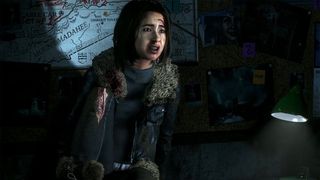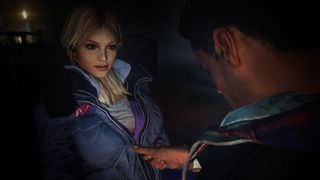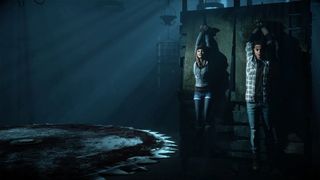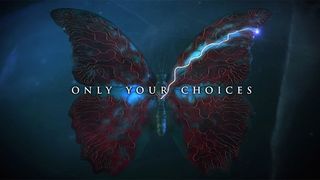Until Dawn is unapologetically one of the most brutal and gory games of 2015. Focused on a group of teenagers trying (and often failing) to survive a night trapped on a mountain with a psychotic killer, it perfectly captures the spirit of hammy slasher horror, never flinching from showing a character getting a meat hook jammed through their throat, or their head popped off like a champagne cork. "My worst playthrough would be if everyone survived," says Creative Director Will Byles, speaking to GamesRadar+ following the game's late-August launch. "Because that would be a dull horror. The best ones are the most gruesome for me."

However, had critical, sweeping changes not been made to the game back in 2012, the dullest and most unfortunate death might have been Until Dawn's own. Originally unveiled at GamesCom 2012, it was set to be the 25th game made exclusively for the PS3 and PlayStation Move, with the peripheral functioning as a flashlight, hand, or gun as the game demanded. While an interesting concept in theory, it ran the risk of becoming instantly gimmicky once the shine wore off. It also compromised Until Dawn's visual quality, according to Byles, as putting the camera and flashlight on the "same axis" made it difficult to see much of the environment.
And then there were external problems looming on the horizon: after the game's 2013 release date was announced, the PS4 was unveiled and scheduled to launch that same year, and the Move was already showing signs of sputtering out. Not surprising, given that Until Dawn was set to be only the 25th Move game four years after the peripheral first launched.

Though Until Dawn was still in its infancy at the time, it was already dealing with the PS3's aging visual processor, and its Move-based gameplay made it difficult to change in a way that would feel natural on the PS4. "For a game that's designed exclusively for one thing," Byles explained, "to try and fit it into something else seems a bit shoehorning." Effectively, a combination of waning hardware, unpopular gimmicks, and a new system launch would have made Until Dawn feel ancient on release day, and give it more in common with Diggs Nightcrawler than the horror games it wanted to stand among as an equal. Until Dawn was headed out into the world to die, eclipsed by bigger and better technology before it even got a chance at life.
Yet, early fan reception proved that there was something there worth saving: "The concept of a teen horror, a playable horror… your own movie, seemed to really catch people's attention," said Byles of the response to Until Dawn's announcement. "There was a… fairly overwhelming demand from the PlayStation community, all over social media saying, 'This is awesome, but we want one that's not Move as well. We don't want to have to buy a Move to play this game’." SuperMassive Managing Director Pete Samuels recalls similar sentiments from fans, showing how much it impacted the team.

Which is why SuperMassive decided to make a change; or rather, a cascading series of them. "[Sony] said, 'You know what? Go back, start again,'" said Byles. "We'll look at a different audience, look at an older demographic, which means we can go slightly more mature in the content."
Naturally, that meant scrapping almost everything the team had built up to that point; however, that actually cleared away the fluff covering up the game's strong visuals and environmental storytelling. Byles claims that adherence to Move controls was particularly troublesome in that regard, because "You lose a lot of the beauty we were trying to get into it, kind of the horror-y, sort of film-y style. What we noticed is that every time we went to a third-person debug camera…it was like 'Oh my God, that looks awesome.'" Plus, because the game was no longer confined to an older system and a type of gameplay that demands all attention be on the object of its execution, there was space to let the score, character personalities, camera work, and settings shine through - basically, much of what made the final version of Until Dawn great.

While these revisions were critical to Until Dawn's new tone and look, the biggest question was what could replace the actual gameplay, which was so centered on the Move that it fell flat on its own - there's only so much traction you can get out of pointing a flashlight in many directions. The answer ultimately came from Byles’ previous experience with interactive dramas, and another game straight out of Sony's treasure trove. "It's got more of a David Cage, Heavy Rain style, which had already [been] well-received," said Byles. "We're going to go way bigger on the choices on this now. So the choices now need to matter, they need to be properly branching, there needs to be a cinematic look."
This is what led to the creation of Until Dawn's butterfly effect, where subtle but important decisions are marked with a butterfly icon to show that the player has just irreversibly changed the future. In place of first-person shooting and flashlight-handling that defined the original version, Until Dawn now has the anxiety of making critical choices that could end in the protagonists' deaths, often in ways that are purposefully vague. "We didn't want to do absolute cause and effect," says Byles. "We didn't want to make it a choice so that you died. We wanted to make it a choice that then kicked off a branch down which you could go, and you could potentially die because of that thing. [That] would allow a much richer level of storytelling."

While this doesn't completely stop Until Dawn from falling into the familiar trap of player choice feeling hollow (when the game forces story points that don't logically agree with the choices you've made) the lack of an obvious chain reaction keeps you on your toes and gives you something more involved to think about. Plus, it highlights the nature of its horror-loyal material on a much deeper level than fumbling through the dark with a torch ever could on its own. What could really bring you into the horror experience more than being just as confused as the dumb teens you usually throw popcorn and shout at during movie night?
The decision didn't come without risks, however. Restarting a project leaves the doors wide open to cancellation (and in fact, many players assumed exactly that when the game failed to materialize, without a word, in 2013), and the proposed changes were marching Until Dawn into some uncertain territory. "There's a significant number of gamers who just don't like interactive dramas," Byles admits frankly, highlighting the sort of criticism leveled at games like Gone Home and Heavy Rain. "It's not hostile or anything like that, they just don't like it. However, there's a growing number of people who do like this stuff, who perhaps weren't always into games in the first place, or can see it for what it is, which is interactive entertainment."

Ultimately, what kept Until Dawn afloat (and impressed both fans and critics when the game finally emerged after a year-long delay) was its loyalty to - and love for - campy horror. "Everyone loved the story," said Byles. "There's a situation where you know absolutely everybody. You know every character, you know the situation, you know the rules. There are no surprises that could possibly happen in this, because you know exactly what's going to go on. And then, we break all those rules."
Until Dawn appears to be nothing less than a gorier-than-normal Cinderella story. The odds were stacked against it back in 2012, and the assumption that it had been canceled was understandable. But Until Dawn survived to kill again because a good idea, a passionate team, and a patient publisher all met in the same place at just the right time. It was an all-or-nothing decision, and it could have ended poorly, but Byles isn't sad the team made the choice that they did. "It's the best thing we could have done. I think we made a much, much better game for it."

